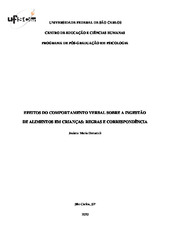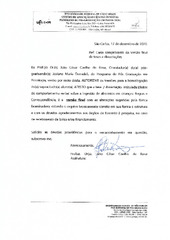| dc.contributor.author | Donadeli, Josiane Maria | |
| dc.date.accessioned | 2020-12-18T21:25:00Z | |
| dc.date.available | 2020-12-18T21:25:00Z | |
| dc.date.issued | 2020-11-13 | |
| dc.identifier.citation | DONADELI, Josiane Maria. Efeitos do comportamento verbal sobre a ingestão de alimentos em crianças: regras e correspondência. 2020. Tese (Doutorado em Psicologia) – Universidade Federal de São Carlos, São Carlos, 2020. Disponível em: https://repositorio.ufscar.br/handle/ufscar/13573. | * |
| dc.identifier.uri | https://repositorio.ufscar.br/handle/ufscar/13573 | |
| dc.description.abstract | The present doctoral dissertation was written in manuscript format. It consists of a summary of the dissertation in non-technical language, a theoretical essay, and three experiments. The theme addressed in this work is the effects of verbalization, from the experimenter and the individual, on the participants' food intake. The general objective was to verify if verbalizations would decrease the amount of unhealthy food eaten and if the use of an intermittent reinforcement schedule would promote the maintenance of this behavior. Three experiments were conducted, with children from 6 to 9 years old, and, in all sessions, nine pieces of healthy food (fruits and nuts) and nine pieces of unhealthy food (e.g., chocolate, cookies, packet snacks) were presented to them.
In Experiment 1 it was examined the effect of a rule provided by the experimenter on the amount of the child's food intake. The rule signaled to child that they could eat only one piece of unhealthy food and as many as they wanted from healthy ones. There were no programmed consequences for following or not following the rule. Also, it was verified whether the rule presented by itself or accompanied by information of health and nutrition would have any effect on the responses. The results indicated that six out of the ten children decreased the amount of unhealthy food eaten during the rule presentation throughout the procedure, two children only decreased it at the beginning of the procedure, and two others did not change their behavior compared to the baseline. Furthermore, the presentation of the information did not change the responses, and all children increased unhealthy food intake when the rule was withdrawn.
Experiment 2 aimed to verify whether the presentation of differential consequences for rule-following and, subsequently, its gradual withdrawal and its total suspension, would promote the maintenance of the behavior of eating less unhealthy food after removing the rule. For this, the children were told that they would earn one stamp, which could be exchanged for a prize, if they followed the rule. Otherwise, they would not earn the stamp. The consequences were provided in a continuous reinforcement schedule, then in intermittent reinforcement schedule, and, finally, they were no longer presented. The results showed that all children decreased the amount of unhealthy food intake when the rule was presented accompanied by the stamp, and five out of the seven children maintained their behavior after withdrawal the consequences.
Finally, Experiment 3 examined the effect of a promise on unhealthy food intake. The child promised to eat no more than one piece of unhealthy food and as many as they wanted from healthy ones. The consequences were provided contingent only to the promise, and, as in the previous experiment, they were also withdrawn gradually, until their total suspension. The results indicated that the promise decreased the amount of unhealthy food eaten for five out of the six children. Two out of the six children were exposed to the correspondence training because they did not present correspondence between promise and eating. For them, the training was effective to promote correspondence and, consequently, reduced the amount of unhealthy food eaten. Five out of the six children maintained their behavior after removal of the consequences.
Another interesting result was that there were children who increased the amount of healthy food eaten: two in experiments 1 and 2, and three in Experiment 3.
The analyzes indicate that the rule changed the behavior, however, for higher effect and maintenance, the rule must be presented with differential consequences. Besides, the promise and correspondence training also increased the frequency of target behavior. Establishing operation is discussed as a variable that possibly influenced the responses. | eng |
| dc.description.sponsorship | Fundação de Amparo à Pesquisa do Estado de São Paulo (FAPESP) | por |
| dc.language.iso | por | por |
| dc.publisher | Universidade Federal de São Carlos | por |
| dc.rights | Attribution-NonCommercial-NoDerivs 3.0 Brazil | * |
| dc.rights.uri | http://creativecommons.org/licenses/by-nc-nd/3.0/br/ | * |
| dc.subject | Comportamento governado por regras | por |
| dc.subject | Autorregra | por |
| dc.subject | Correspondência dizer-fazer | por |
| dc.subject | Alimentação | por |
| dc.subject | Operantes verbais | por |
| dc.subject | Manutenção | por |
| dc.subject | Rule-governed behavior | eng |
| dc.subject | Self-rule | eng |
| dc.subject | Say-do correspondence | eng |
| dc.subject | Nutrition | eng |
| dc.subject | Verbal operants | eng |
| dc.subject | Maintenance | eng |
| dc.title | Efeitos do comportamento verbal sobre a ingestão de alimentos em crianças: regras e correspondência | por |
| dc.title.alternative | Effects of verbal behavior on children's food intake: rules and correspondence | eng |
| dc.type | Tese | por |
| dc.contributor.advisor1 | Rose, Julio Cesar Coelho de | |
| dc.contributor.advisor1Lattes | http://lattes.cnpq.br/3386857761295187 | por |
| dc.description.resumo | A presente tese foi escrita em formato de manuscritos. Ela é composta por um resumo da tese em linguagem não técnica, um ensaio teórico e três experimentos. O tema abordado no trabalho são os efeitos da verbalização, provenientes do experimentador e do próprio indivíduo, sobre a ingestão de alimentos dos participantes. O objetivo geral foi verificar se as verbalizações diminuiriam a quantidade de alimentos não saudáveis ingeridos, e se o uso de um esquema de reforçamento intermitente promoveria a manutenção desse comportamento. Foram realizados três experimentos, com crianças de 6 a 9 anos de idade, e, em todas as sessões, eram apresentados a elas nove pedaços de alimentos saudáveis (frutas e castanhas) e nove pedaços de alimentos não saudáveis (e.g., chocolate, biscoito, salgadinho de pacote).
No Experimento 1 examinou-se o efeito de uma regra fornecida pela experimentadora sobre a quantidade de alimentos ingeridos pela criança. A regra sinalizava a ela que poderia comer apenas um pedaço dos alimentos não saudáveis e quantos pedaços quisesse dos saudáveis. Não havia consequências programadas por seguir ou não a regra. Além disso, foi verificado se a regra apresentada isoladamente ou acompanhada de informações sobre saúde e alimentação teria algum efeito sobre as repostas. Os resultados indicaram que seis das dez crianças diminuíram a quantidade de alimentos não saudáveis ingeridos durante a apresentação da regra ao longo do procedimento, duas apenas diminuíram no início dele, e para outras duas crianças, não houve alteração do comportamento em relação à linha de base. Ademais, a apresentação das informações parece não ter alterado o comportamento, e todas as crianças aumentaram a ingestão de alimentos não saudáveis quando a regra foi suspensa.
O Experimento 2 teve como objetivo verificar se a apresentação de consequências diferenciais para o seguimento da regra e, posteriormente, a retirada gradual delas até sua total suspensão, promoveria a manutenção do comportamento de ingerir menor quantidade de alimentos não saudáveis após a retirada da regra. Para isso, era dito às crianças que elas ganhariam um selo, o qual poderia ser trocado por brindes, se seguissem a regra. Caso contrário, não o ganhariam. As consequências foram fornecidas em esquema de reforçamento contínuo, depois, em esquema de reforçamento intermitente, e, por último, elas não foram mais apresentadas. Os resultados demonstraram que todas as crianças diminuíram a quantidade de alimentos não saudáveis ingeridos quando a regra estava em vigor e acompanhada da apresentação do selo, e cinco das sete crianças mantiveram o comportamento após a suspensão das consequências e da regra.
Por fim, o Experimento 3 examinou o efeito de uma promessa sobre a ingestão de alimentos não saudáveis. A criança prometia ingerir até um pedaço dos alimentos não saudáveis e quantos quisesse dos saudáveis. As consequências foram fornecidas contingentes apenas à promessa, e, como no experimento anterior, elas também foram retiradas gradualmente, até sua total suspensão. Os resultados indicaram que a promessa diminuiu a quantidade de alimentos não saudáveis ingeridos para cinco das seis crianças. Duas das seis realizaram um treino de correspondência por não apresentarem correspondência entre a promessa e o comer. Para elas, o treino foi efetivo para estabelecer a correspondência e, consequentemente, diminuir a quantidade de alimentos não saudáveis ingeridos. Cinco das seis crianças mantiveram o comportamento alvo após a retirada total das consequências.
Outro resultado interessante encontrado foi que, em todos os experimentos, houve crianças que aumentaram a quantidade de alimentos saudáveis ingeridos: duas nos experimentos 1 e 2, e três no Experimento 3.
As análises indicam que a regra favoreceu a mudança de comportamento, porém, é importante, para um maior efeito e manutenção, que seja apresentada com consequências diferenciais. Além disso, a promessa e o treino de correspondência também aumentaram a frequência do comportamento alvo. Discute-se a operação estabelecedora como variável que possivelmente influenciou as respostas. | por |
| dc.publisher.initials | UFSCar | por |
| dc.publisher.program | Programa de Pós-Graduação em Psicologia - PPGPsi | por |
| dc.subject.cnpq | CIENCIAS HUMANAS::PSICOLOGIA | por |
| dc.description.sponsorshipId | FAPESP: 2017/01216-8 | por |
| dc.publisher.address | Câmpus São Carlos | por |
| dc.contributor.authorlattes | http://lattes.cnpq.br/1926593718009886 | por |


